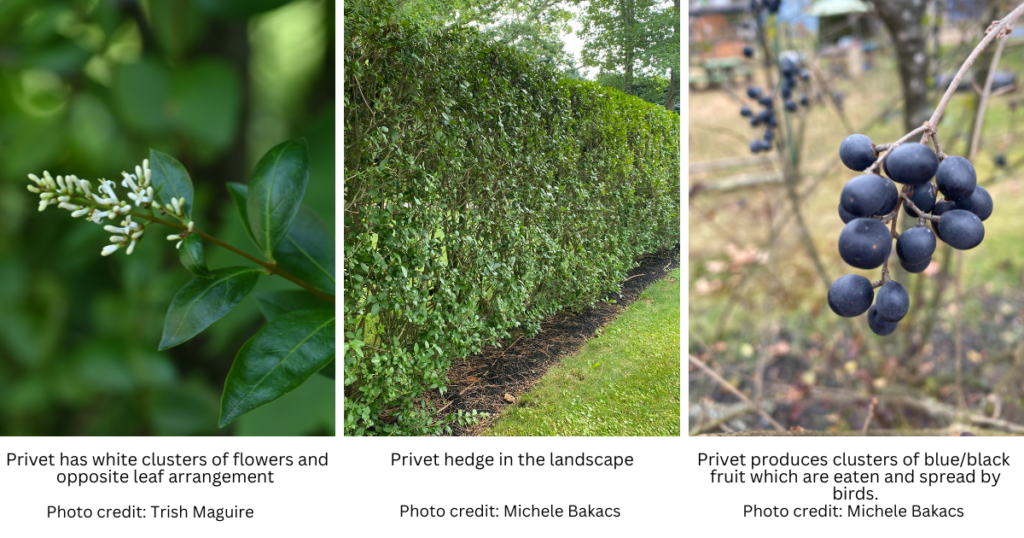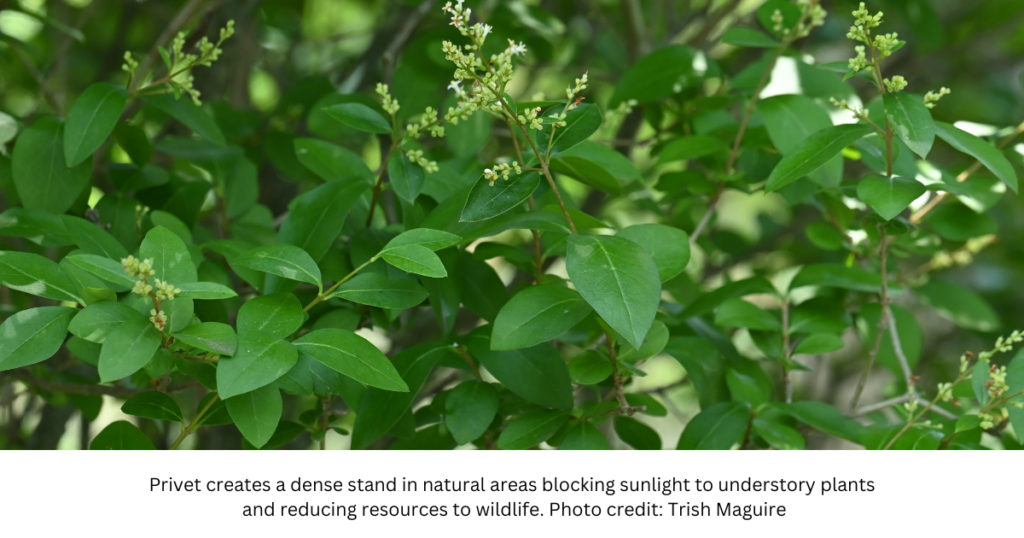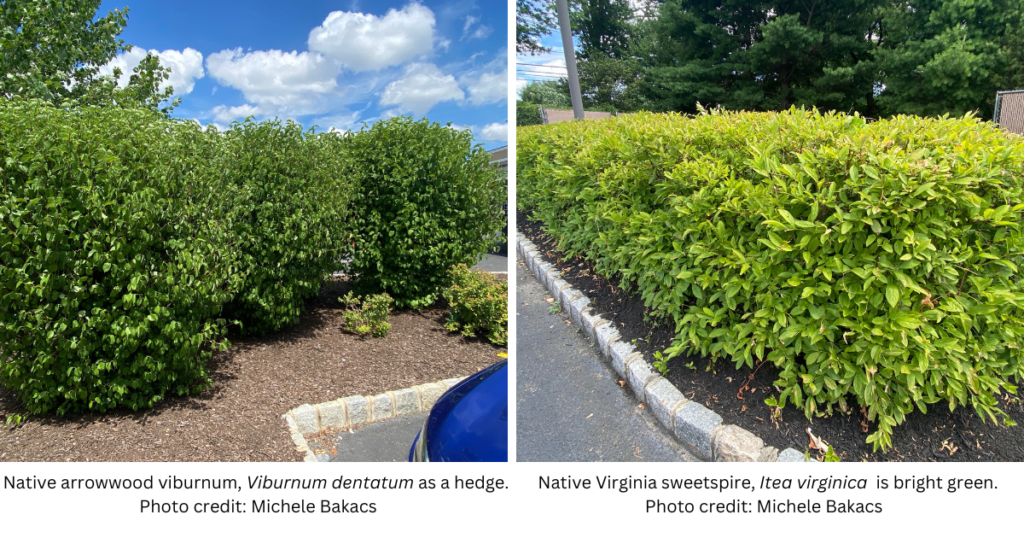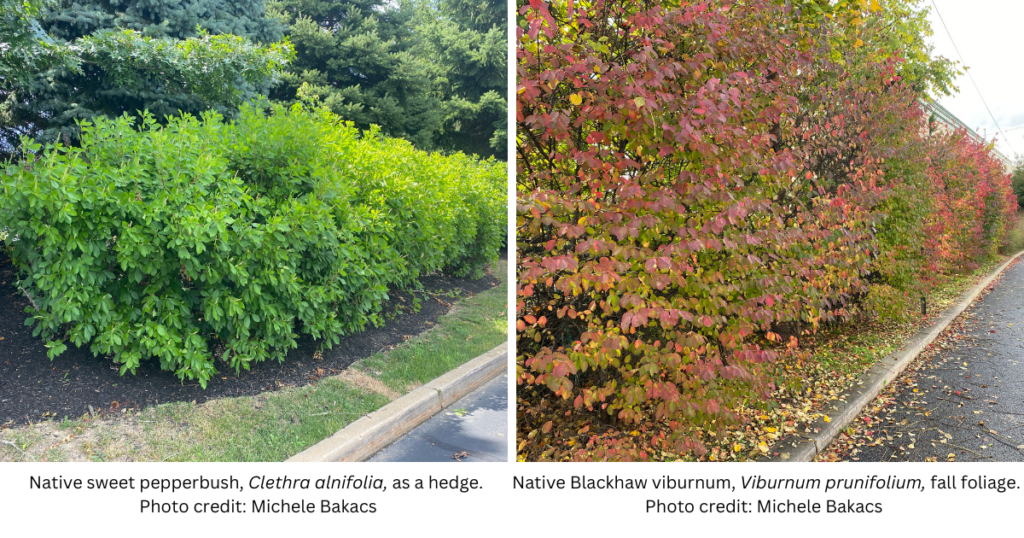Main Content
Is the “Invasive Species of the Month” useful to you? Let us know how.
Privet, Ligustrum spp.
Privet, Ligustrum species, is an invasive, flowering, deciduous shrub. Various privet species are commonly used as hedges in residential and commercial landscapes. Some privet species have spread into understory forests and roadsides. Both border privet, Ligustrum obtusifolium, and European privet, Ligustrum vulgare are considered widespread, invasive plants in New Jersey. Privet can grow in both full sun and shade. Due to its tolerance of a wide range of conditions it can displace native shrubs that wildlife depend on for high quality habitat.
Description: Privet species are multi-stemmed shrubs that grow up to 15 feet. The simple, bright green leaves have an opposite arrangement on the stem and a smooth margin. Leaves can be anywhere from 1 to 3 inches in length. The young stems are pubescent (soft, short hairs) while older branches are smooth and grey. Spurs or sharp pointed branches resembling thorns may be present. The small, white, flowers are bell shaped and appear along the stem or near the branch tips depending on the species. Privet’s white flower blooms from mid-May through the end of June. The fruit is a cluster of drupes, green in the summer and then turns blue/black and persist on the stem into the winter. It can be difficult to distinguish between the different privet species when not in flower.
Ecological threat: This invasive shrub displaces native vegetation in the shrub layer thereby reducing resources available for wildlife. Privet grows in dense stands blocking sunlight from reaching understory seedlings and stifling natural forest regeneration. Deer do not eat it as they prefer the native vegetation. Other privet species are even more invasive in the southeastern states (for example Ligustrum sinense) suggesting this species may become more dominant in New Jersey’s warming climate.
Method of spread: Privet spreads by seeds eaten and dispersed by birds. It is also commercially available as it is fast growing and popular as an ornamental hedge. It appears to spread via sprouts, forming an outwardly expanding colony.
Removal method: For manual control, when infestations are small, shrubs can be dug up by the roots. Roots will re-sprout if left in the ground. Another manual option is repeated cutting as new growth appears throughout the growing season to exhaust the root system. DO NOT compost the seeds or cuttings. For larger infestations, shrubs can still be cut but will likely need to be followed up with foliar spray when shrubs start to grow back. Early detection/rapid response is the ideal method for control; learn to identify this shrub in small seedling stages and monitor at-risk locations regularly.
For chemical control, foliar applications with glyphosate are effective when leaves are present. Cut-stump or basal bark treatment applied throughout the year are also effective. Always follow the herbicide label instructions; the label is the law. Post treatment, make sure to monitor the area for re-sprouts and new individuals for multiple seasons. Information about seed viability is limited. For more information on control strategies visit Penn State Extension.
If you are not able to use or comfortable with using herbicides, but have a privet invasion that needs attention, hire a landscape professional that has a pesticide license and specializes in invasive plant management.
Native alternatives for hedges and screens: Do not plant privet. New Jersey has many native shrubs that work well if looking for replacement species for hedges and screens. Hedges do not have to be a traditional, sheared, monoculture of one plant species. Hedges can be layered with multiple native species that provide seasonal interest and wildlife habitat throughout the year. If looking for a more formal, uniform aesthetic, consider planting the same species mix in repeated patterns.
The following native shrubs respond well to pruning or can have a more natural look:
Arrowood viburnum, Viburnum dentatum does well in part shade and dry conditions but can tolerate full sun. It is deer resistant.
Blackhaw viburnum, Viburnum prunifolium thrives in part shade with moist soil, but can tolerate sunnier conditions and some drought. All viburnums have large white blooms in the spring.
Inkberry holly, Ilex glabra, is an evergreen shrub that does well in moist soil from full sun to part shade. It is deer resistant.
Red osier Dogwood, Cornus sericea does well in full sun with moist soil but can tolerate part shade and drier conditions. It has two seasons of interest with beautiful white flowers in the spring and red stems in the winter.
Spicebush, Lindera benzoin, does well in part sun to shade in moist to average soils. It has small yellow flowers in the early spring along the branches. It is also the host plant to the spicebush swallowtail butterfly.
Summersweet or Sweet pepperbush, Clethra alnifolia, tolerates moist conditions and its white flowers clusters in midsummer have a lovely floral scent. It is a versatile species that grows in full sun to shade.
Virginia sweetspire, Itea virginica thrives in part sun in acidic moist to wet rich soils; it can tolerate mostly sunny conditions to shade and some drought. It has two seasons of interest with beautiful white flowers in the spring and deep purple, red fall color.
Additional references and resources for native alternatives and controlling privet:
Controlling Non-Native Invasive Plants in Ohio Forests: Privet (Ligustrum spp.)
Illinois Extension: Invasive Privet
Invasive Plants and Native Alternatives for Landscapes
Mississippi State University Extension: Privet
Native Hedges and Hedgerows: Beauty and Biodiversity
New Jersey Invasive Species Strike Team Fact Sheets
Thank you to our reviewers: John Landau, Roslyn Dvorin, Trish Maguire, and Michael VanClef
The goal of Rutgers Cooperative Extension’s “Invasive Species of the Month” is to highlight those organisms that are non-native to New Jersey and cause economic or environmental harm, or harm to human health. We can all help prevent the spread of invasives by learning which species are a threat to our ecosystems.




